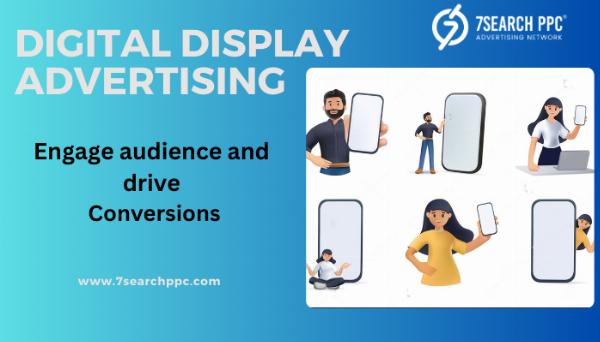From Clicks to Conversions: Mastering Digital Display Advertising?

Strong 8k brings an ultra-HD IPTV experience to your living room and your pocket.
In today's digital landscape, businesses are constantly seeking effective ways to engage their audience and drive conversions. One powerful method is Digital Display Advertising, a strategy that leverages visuals to capture attention and compel action. This blog will explore the intricacies of digital display advertising, its benefits, and how to effectively implement it to maximize your marketing efforts.
Click here to advertise
Understanding Digital Display Advertising
What is Digital Display Advertising?
Digital display advertising involves the use of visually appealing ads that appear on websites, social media platforms, and apps. These ads can take various forms, including banners, videos, and rich media. The primary goal of digital display advertising is to promote products or services and drive users to take specific actions, such as making a purchase or signing up for a newsletter.
Key Components of Digital Display Advertising
Digital display advertising consists of several key components:
Ad Formats: These include static images, animated graphics, video ads, and interactive formats. Choosing the right format is crucial for grabbing attention and conveying your message effectively.
Targeting Options: Display ads can be targeted based on demographics, interests, behaviors, and even retargeting previous visitors to your website. This precision helps ensure your ads reach the right audience.
Ad Networks: Platforms like Google Display Network, Facebook Ads, and others facilitate the placement of display ads across a vast range of sites. Selecting the right network is essential for maximizing reach and effectiveness.
Analytics and Tracking: Measurement tools help marketers track performance metrics such as click-through rates (CTR), impressions, and conversions. Analyzing this data is vital for optimizing campaigns.
The Benefits of Digital Display Advertising
Increased Brand Awareness
One of the primary advantages of digital display advertising is its ability to boost brand visibility. Display ads are often strategically placed on high-traffic websites, ensuring that your brand gets in front of a large audience. The more people see your ads, the more likely they are to remember your brand when making purchasing decisions.
Enhanced Targeting Capabilities
Unlike traditional advertising methods, digital display advertising allows for advanced targeting. Marketers can use demographic data, user interests, and behaviors to reach specific segments of their audience. This level of precision increases the likelihood of conversions, as the ads resonate more with potential customers.
Cost-Effective Advertising
Digital display advertising is often more cost-effective than traditional forms of advertising, such as print or TV. With options like pay-per-click (PPC) and cost-per-thousand impressions (CPM), businesses can control their advertising budgets and optimize spending based on performance.
Versatility and Creative Freedom
Digital display ads offer immense versatility in terms of design and format. Marketers can experiment with different visuals, copy, and calls-to-action to find what resonates best with their audience. This creative freedom allows for ongoing optimization and innovation.
Mastering Digital Display Advertising Strategies
Define Your Goals
Before launching a digital display advertising campaign, it’s essential to establish clear objectives. Whether your goal is to increase brand awareness, generate leads, or boost sales, defining specific, measurable goals will guide your campaign strategy.
Understand Your Target Audience
A deep understanding of your target audience is crucial for crafting effective display ads. Utilize demographic and psychographic data to identify your ideal customers. This knowledge will inform your messaging, design, and targeting strategies.
Creating Customer Personas
Creating detailed customer personas can help you visualize your target audience. Consider factors like age, gender, interests, and pain points. By understanding who your customers are, you can create more compelling and relevant ads.
Choose the Right Ad Formats
Select ad formats that align with your goals and audience preferences. For instance, video ads can be highly engaging and effective for storytelling, while static banners may be better suited for straightforward promotions. Experiment with different formats to find what works best for your brand.
Utilize Targeting Options Effectively
Leverage the various targeting options available in digital display advertising. Use demographic targeting to reach specific age groups or genders, and employ behavioral targeting to engage users based on their online habits. Retargeting ads can also help re-engage users who have previously interacted with your brand.
Optimize Your Landing Pages
Driving clicks to your ads is only half the battle; you also need to ensure that your landing pages are optimized for conversions. Make sure your landing pages are relevant to the ad content, load quickly, and provide a seamless user experience. A well-designed landing page can significantly improve conversion rates.
Monitor and Adjust Your Campaigns
Constantly monitor your campaign performance using analytics tools. Keep an eye on key metrics such as CTR, conversion rates, and cost-per-conversion. Use this data to make informed adjustments to your ads, targeting, and bidding strategies.
Exploring Native Advertising
What is Native Advertising?
Native Advertising is a form of digital display advertising that blends seamlessly with the content of the platform on which it appears. Unlike traditional display ads, which can be easily identified as advertisements, native ads match the look and feel of the surrounding content, making them less intrusive and more engaging.
Benefits of Native Advertising
Higher Engagement Rates: Because native ads mimic the surrounding content, they often result in higher engagement rates compared to traditional display ads.
Improved Brand Perception: Native advertising can enhance brand perception by providing valuable content rather than overt promotional messages.
Better Ad Performance: Studies have shown that native ads tend to perform better in terms of click-through rates and conversions.
Best Practices for Native Advertising
Create High-Quality Content: Focus on providing valuable, informative content that resonates with your audience. This will increase the likelihood of engagement and sharing.
Maintain Transparency: Clearly label native ads as sponsored content to maintain trust with your audience. Transparency is key to fostering positive relationships with consumers.
Optimize for Mobile: With a growing number of users accessing content on mobile devices, ensure that your native ads are optimized for mobile viewing.
Conclusion
Digital display advertising is a powerful tool for businesses looking to increase brand awareness, drive traffic, and boost conversions. By understanding the intricacies of this advertising method and implementing effective strategies, you can turn clicks into meaningful conversions.
Incorporate the principles of digital display advertising and consider the potential of native advertising to further enhance your marketing efforts. As you navigate this dynamic landscape, continuous learning and adaptation will be your best allies in mastering the art of digital display advertising.
Note: IndiBlogHub features both user-submitted and editorial content. We do not verify third-party contributions. Read our Disclaimer and Privacy Policyfor details.







